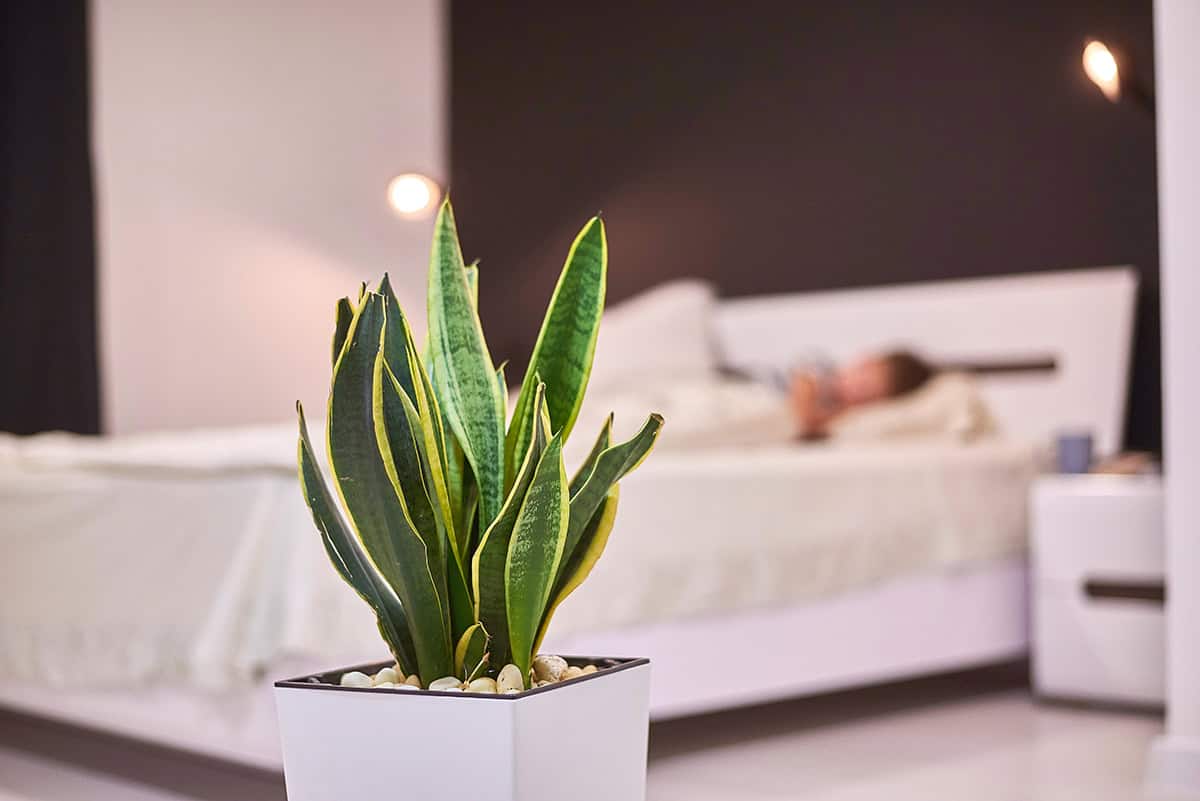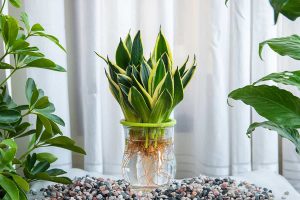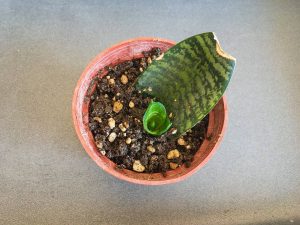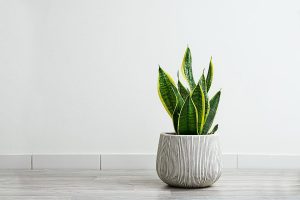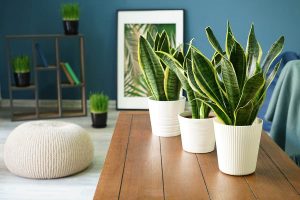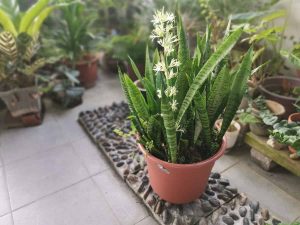Ever wake up to stuffy air and wish your bedroom felt just a bit fresher? A snake plant might be the answer—and it looks great, too. This nearly indestructible plant can make a difference in air quality without demanding much from you.
Some studies suggest it’ll filter out a few indoor pollutants, so your sleep space feels a little nicer. Place it well and give it basic care, and it’ll stick around for the long haul.
Table of Contents
What Is Mother-In-Law’s Tongue?
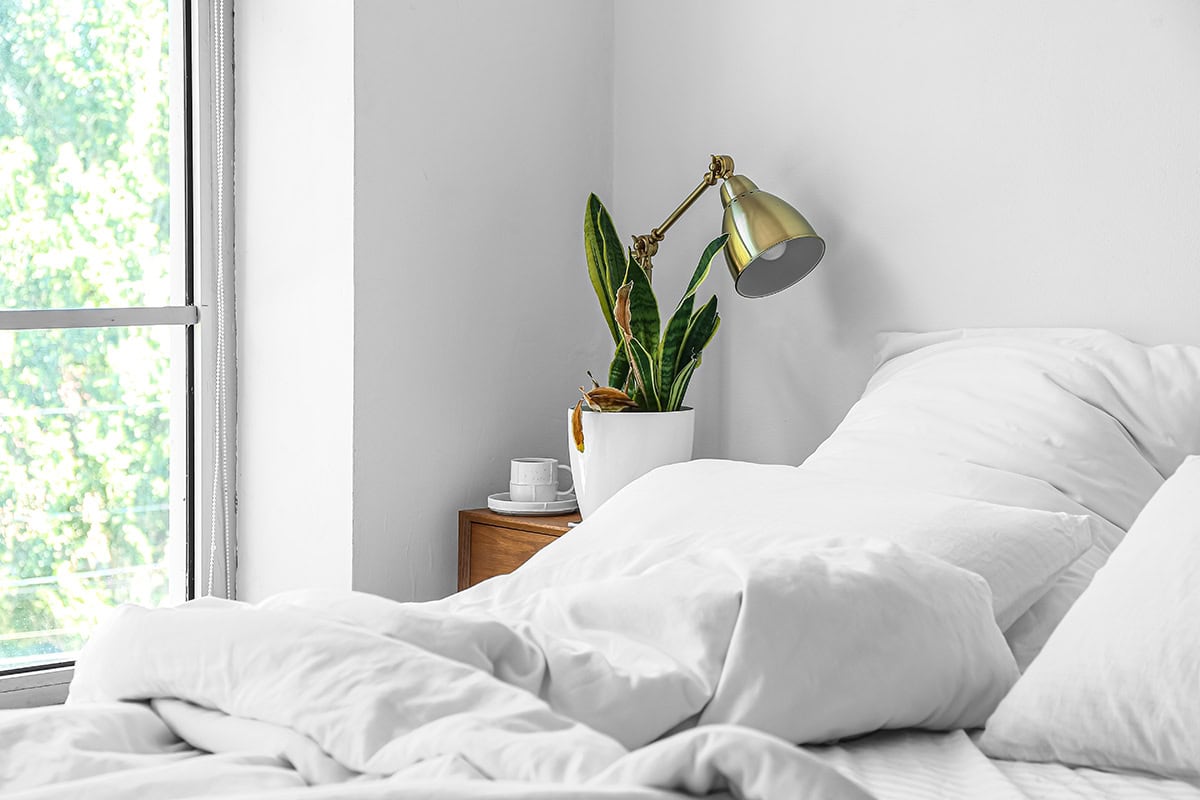
This is one of those houseplants that practically thrives on neglect. The upright leaves are hard to miss, and they’re tough enough to handle whatever your room throws at them.
Quick Facts And Names
This plant goes by a few names: snake plant, mother-in-law’s tongue, or Sansevieria trifasciata. For the botanically curious, it’s now lumped into the Dracaena family.
Originally, it comes from tropical parts of Africa, where it’s used to hot, dry weather. Indoors, it’s not fussy—low light, bright indirect light, whatever you’ve got.
As a succulent perennial, it stores water in its leaves, so it’ll forgive you if you forget to water. Give it a bit of care and it’ll stick around for years.
Mature plants sometimes surprise you with small, greenish-white flowers on tall stalks—usually rare indoors but not impossible.
How It Looks
The leaves shoot straight up, almost like swords. Outdoors, they can get pretty tall—inside, they’re usually around 2 feet.
Colors range from deep green to patterns with yellow or silvery edges. The leaves are smooth, tough, and end in a point.
Growth is mostly vertical and dense, so it’s perfect for tight spots. The foliage stays green all year.
It’s not a fast grower, which is honestly a plus if you don’t want to deal with constant pruning or repotting.
How It Improves Indoor Air
If you’re hoping for cleaner air, this plant can help—just don’t expect miracles. It’s happy in low light, which makes it a good fit for bedrooms.
What It Removes From The Air
Snake plants can soak up some volatile organic compounds (VOCs) like benzene, formaldehyde, and toluene—stuff that sneaks in from things like furniture and cleaning supplies.
They also pull in carbon dioxide and push out oxygen as they photosynthesize. NASA’s old studies in sealed rooms found they help with indoor toxins, though the effect at home is subtle.
Honestly, you’d need a jungle of them to see big lab-style results, but even one or two can freshen things up when paired with decent ventilation.
Why It Works In Bedrooms
Unlike most plants, snake plants pump out oxygen at night thanks to a process called Crassulacean Acid Metabolism (CAM).
This means your bedroom air might feel a bit fresher while you sleep. They’ll also keep absorbing carbon dioxide even if your room’s not super bright.
Since they’re so low-maintenance, you can stick one in a bedroom corner and forget about it. They handle dry, heated air without fuss, which is perfect for most bedrooms.
Main Benefits For Health
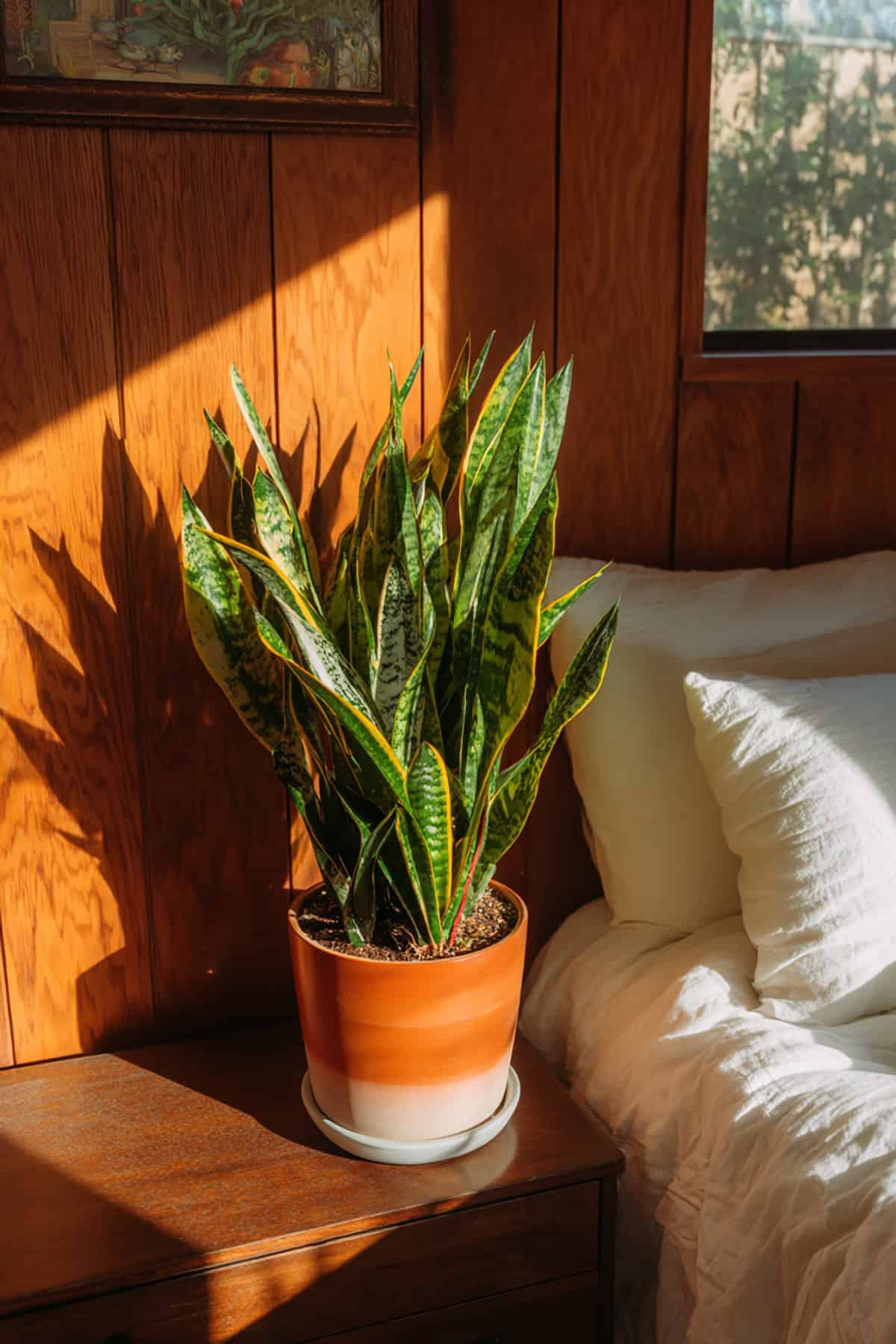
Cleaner air in your bedroom can make breathing and sleeping a little easier. Snake plants filter out some airborne stuff that isn’t great for your lungs.
Helps With Pet Allergies
Got pets? You know the struggle with dander. Snake plants can help by catching some of those particles. NASA’s research suggests they absorb things like formaldehyde and benzene, which often ride along with dust and dander.
Cleaner air could mean fewer sneezing fits at night. It’s not a replacement for cleaning or a good air purifier, but it’s a nice bonus. If your pets hang out in your room, keeping a snake plant nearby might help keep the air a bit clearer.
Makes Breathing Easier For Asthma
Stale, dusty air is rough if you have asthma. Snake plants can trap some toxins and dust, plus add oxygen, which might make your lungs a little happier.
They’re pretty good at catching airborne particles on their leaves. Less dust and fewer allergens can mean less nighttime coughing or wheezing.
Of course, always stick to your asthma plan. But a snake plant could make your bedroom feel less stuffy and irritating.
Improves Sleep And Reduces Insomnia
Stuffed-up air and low oxygen can make falling asleep tough. Since snake plants release oxygen at night, your room might feel less closed-in.
Breathing easier could help you unwind before bed. If you’re a light sleeper, better air might help you stay asleep longer.
Keep the plant within a few feet of your bed if you want to really notice the difference. No need to go overboard—one healthy plant is enough for most bedrooms.
Other Good Things About This Plant
Besides helping your air, this plant is ridiculously easy to live with. It’s perfect if you’re busy or just forgetful.
Helps You Focus And Feel Better
Cleaner air can make it easier to pay attention and feel a bit sharper. Snake plants can absorb some pollutants, which might help with those random headaches or tired spells you get indoors.
You might notice fewer annoyances from dry air or weird odors, too. A steady, comfy vibe makes it easier to get stuff done or just relax.
Lots of people keep them near desks or reading nooks. If you want your bedroom to feel calm and steady, it’s a good move.
Keeps CO₂ Levels Lower
Snake plants use CAM photosynthesis, so they’re pulling in carbon dioxide at night, not just during the day.
Lower CO₂ in a closed room can make things feel fresher. You might even wake up feeling a bit more rested.
The effect isn’t huge, but in stuffy rooms or apartments where you can’t crack a window, every bit helps. One plant is usually enough for a small space.
Easy To Look After
You can forget to water for weeks and it won’t mind. Those thick leaves are like little water tanks.
It’s just as happy in low light as it is in bright, indirect light. Super flexible for wherever you want to put it.
Pruning? Not really needed. Just snip off any sad-looking leaves at the base.
It shrugs off most pests and diseases, so you’ll spend less time fussing over it. If you want a plant that basically takes care of itself, this is the one.
How To Care For It

Snake plants are adaptable, but a few basics will keep them looking their best. Focus on light, water, temperature, and soil, and you’re set.
Light
These plants aren’t picky. They prefer bright, indirect light, but low light is fine too.
Direct sun for hours can burn the leaves, though. In a dim bedroom, growth might slow, but the plant won’t throw a fit.
If you want richer color and faster growth, aim for an east- or west-facing window. Give the pot a spin now and then for even growth.
How Often To Water
Less is more here. Let the top inch or two of soil dry out before watering—usually every 2–4 weeks indoors.
Too much water is the main way people kill these. Always use a pot with drainage holes and dump any extra water from the saucer.
Temperature It Likes
Room temperature is perfect—anywhere from 60°F to 85°F.
It’ll survive a brief dip to 50°F, but don’t push your luck. Keep it away from cold drafts in winter.
Hot air from vents or radiators can dry it out fast. Try to keep it in a spot with steady temps.
Best Soil And Pot
Loose, fast-draining soil is best. Cactus or succulent mixes work great.
Or just mix potting soil with sand or perlite. Avoid anything that stays soggy.
Drainage holes are a must. Terra-cotta pots help the soil dry out faster and keep roots happy.
Pet Safety Tip
Heads up: snake plants aren’t pet-friendly if chewed. They can cause mild stomach upset in cats and dogs.
If your pets are plant nibblers, put the pot somewhere they can’t reach—think high shelves or hanging planters.
If your pet does eat some, call your vet. It’s just safer to keep it out of reach.
Best Places To Put It In Your Bedroom
Where you put your snake plant matters. Light, airflow, and convenience all play a part in how well it does.
Beside The Bed
Next to the bed is a classic spot—close enough to enjoy the benefits while you sleep. Floor or a low stand both work.
Just make sure it’s not in the way, since those leaves are tough but can snap if bumped a lot.
Keep it away from heaters or radiators, and leave a little space from the wall for air to circulate.
Near A Window Or Air Vent
Near a window with filtered light is ideal. East- or west-facing windows are usually best.
Avoid direct, harsh sun—it can scorch the leaves. Sheer curtains help soften the light.
If you put it near an air vent, make sure the airflow isn’t too strong. Rotate the pot every so often for even growth.
On A Table Or Dresser
If you’re short on floor space, a table or dresser makes the plant more of a feature. Just pick a sturdy spot.
Use a saucer to catch any water and protect your furniture.
Don’t put it right under a hot lamp. Moderate light is all it needs to keep looking good.
In A Pet’s Favorite Spot
Got a furry friend who’s claimed a certain corner? Probably best not to put your snake plant there. Turns out, these plants aren’t exactly pet-friendly—cats and dogs can get an upset stomach if they decide to nibble.
Try moving the plant up high, maybe on a shelf or a stand, somewhere paws can’t reach. If you’re stuck with floor space, a little creativity goes a long way—maybe a barrier, or just some gentle training. Keep an eye out for any sneaky chewers, because even a quick bite can be enough to make them sick.
